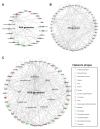Integration of metabolomics and transcriptomics in nanotoxicity studies
- PMID: 29301609
- PMCID: PMC5796629
- DOI: 10.5483/bmbrep.2018.51.1.237
Integration of metabolomics and transcriptomics in nanotoxicity studies
Abstract
Biomedical research involving nanoparticles has produced useful products with medical applications. However, the potential toxicity of nanoparticles in biofluids, cells, tissues, and organisms is a major challenge. The '-omics' analyses provide molecular profiles of multifactorial biological systems instead of focusing on a single molecule. The 'omics' approaches are necessary to evaluate nanotoxicity because classical methods for the detection of nanotoxicity have limited ability in detecting miniscule variations within a cell and do not accurately reflect the actual levels of nanotoxicity. In addition, the 'omics' approaches allow analyses of in-depth changes and compensate for the differences associated with high-throughput technologies between actual nanotoxicity and results from traditional cytotoxic evaluations. However, compared with a single omics approach, integrated omics provides precise and sensitive information by integrating complex biological conditions. Thus, these technologies contribute to extended safety evaluations of nanotoxicity and allow the accurate diagnoses of diseases far earlier than was once possible in the nanotechnology era. Here, we review a novel approach for evaluating nanotoxicity by integrating metabolomics with metabolomic profiling and transcriptomics, which is termed "metabotranscriptomics". [BMB Reports 2018; 51(1): 14-20].
Conflict of interest statement
The authors have no conflicting interests.
Figures


References
-
- Deng R, Lin D, Zhu L, et al. Nanoparticle interactions with co-existing contaminants: Joint toxicity, bio-accumulation and risk. Nanotoxicology. 2017:1–56. - PubMed
Publication types
MeSH terms
LinkOut - more resources
Full Text Sources
Other Literature Sources

